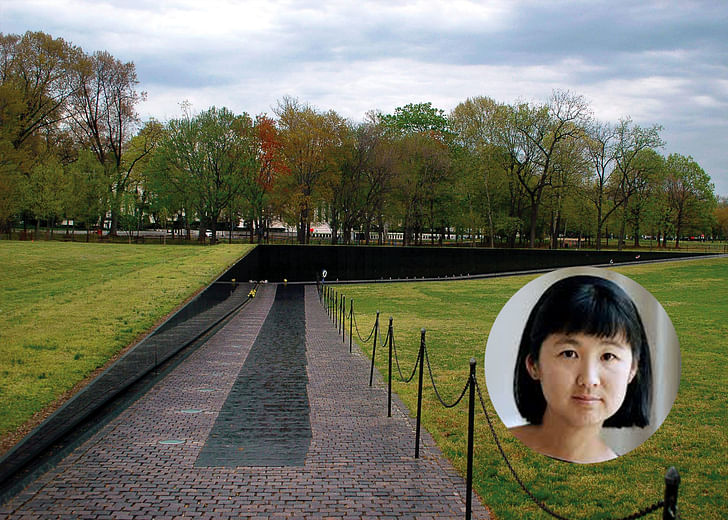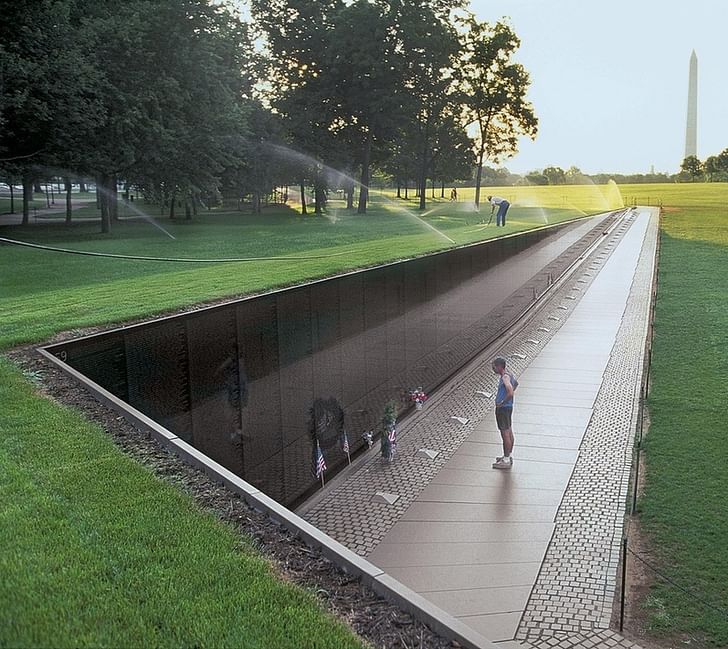

From the Ground Up is a series on Archinect focused on discovering the early stages & signs of history's most prolific architects. Starting from the beginning allows us to understand the long journey architecture takes in even the formative of hands and often, surprising shifts that occur in its journey. These early projects grant us a glimpse into the early, naive, ambitious and at points rough edges of soon to be architectural masters.
Every single student of architecture sits at their desk on a daily basis with the aspirations and naive hopefulness of seeing some iteration of their experimental exuberance built. Even with the highest levels of achievement, it would be hard to come across the success that Maya Lin achieved right out of the gate with her Vietnam Memorial.
The project itself stemmed from the process and development of a studio at Yale's School of Architecture. With the support of a passionate professor's, Lin submitted her project and subsequently, won the official architectural competition for a Vietnam Memorial.
Maya's design made a space for both physical and spiritual reflection for all those that were to visit.
The competition itself, on a whole, brought in over 1,400 submissions. As the projects were all being submitted anonymously, they were explicitly selected from their designs only. Such a framework allowed Maya's project to be selected as it leveled the playing field and accommodated pure ideas, bringing a student to the same height as experienced architects of the time.

While her project itself won the competition, it only earned a B at Yale. When the results were revealed to Maya, it was no surprise that she herself was amazed at the outcome — especially when the professor who had asked her to submit her project, had also submitted his own, and had thus lost to his own student.
Maya's design called for the names of nearly 58,000 American servicemen, listed in chronological order of their loss, to be etched in a V-shaped wall of polished black granite sunken into the ground. Maya's design constructed and amplified a space for both physical and spiritual reflection for all those that visit.
Although Maya designed an apolitical monument, the politics of the Vietnam War could not be avoided. Like the war itself, the monument proved controversial. Veterans groups decried the lack of patriotic or heroic symbols often seen on war memorials and complained that it seemingly honored only the fallen and not the living veterans. Yet, after the memorial wall was unveiled on November 13, 1982, the controversy quickly subsided. Maya has since gone on to design more memorials and other various architecture projects but, will always be associated with the success and narrative of the Vietnam Memorial.
Anthony Morey is a Los Angeles based designer, curator, educator, and lecturer of experimental methods of art, design and architectural biases. Morey concentrates in the formulation and fostering of new modes of disciplinary engagement, public dissemination, and cultural cultivation. Morey is the ...
9 Comments
I was in her airspace and knew her critic when she did this: I must say, it is the best thing I can imagine, so powerful the pics are simply inadequate. Its power is, truly, overwhelming: It is the one argument that "Style" is nothing - even the most Mod-phobic folk I know are completely blown away by it. I did not serve, missed being drafted by a year: but this "thing" is deeply moving....I feel gratitude along with the deep sorrow she conveyed, or perhaps channelled..
the effect of walking down into the V is literally stunning; descending into the abyss, but with no fear, just awe — at everything: the removal of the city as if a time warp; the names, the names the names, the names, more and more and more and ever: M O R E — the exquisite granite and the precision of incisions: unchangeable, infinite, lives gone forever into the deep dark glistening wall....
Then! — at the deepest, darkest point of V, suddenly the reflexction of the Lincoln Memorial on one wall and, a few steps later, the Capitol on the other! —WOW!
The architect in me immediately thought how the slightest change in the V angle would have merged the two images.
That is the difference between the young talent and one wise with experience; it would not make the feeling (architecture) more perfect; it would have added another dimension of history about war and people of different color skin, as the words of Mohamed Ali did when he objected; that’s all.
It's a beautiful memorial that works on so many levels. Truly humane.
"The project drew its inspiration from a similar memorial, with inscribed"
The sentence isn't finished, so which memorial, with inscribed what?
I can't find this sentence, so maybe your question is already answered;however, if I remember correctly, the
Thiepval Memorial was likely a precedent.
http://www.isisinform.com/names-on-a-memorial-comrades-in-vietnam-and-the-somme/
yep, the article was updated
The names on the wall are NOT part of the design solution!
The display of the names is a REQUIREMENT of the program.
Block this user
Are you sure you want to block this user and hide all related comments throughout the site?
Archinect
This is your first comment on Archinect. Your comment will be visible once approved.